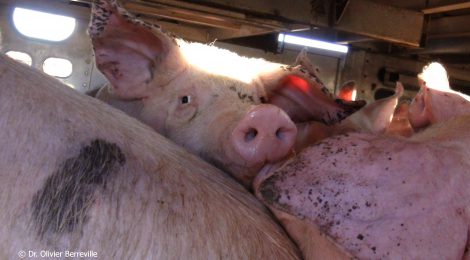
New Animal Transportation Regulations a Betrayal
On Wednesday, the federal government finally released its revised animal transport regulations, which had remained unchanged since 1977. The new regulations are nothing but a betrayal to farmed animals as well as the 51,000 Canadians who submitted comments demanding better protection for animals during transportation.
The new regulations reduce maximum transport times slightly but ignore the best available scientific evidence which advances that animals should not be transported for more than eight hours without a break (which is what the current legislation is in Europe*), instead choosing to cater to industry by continuing to allow farmed animals to be transported for days without food, water or rest. In fact, the new maximum transport times are based on current infrastructure, transport routes and existing industry practices, not science or animal welfare. Almost no improvements related to transport times have been made for animals, which the government readily admits by stating in its Background statement:
Overall, 98% of current shipments will not be affected by the new requirements.
In fact, the regulations even stipulate that for certain vehicles (furnished), NO maximum transport times will apply. In Europe, where such trailers are standard, maximum transport time still remains eight hours, after which time animals must be unloaded, rested and provided food and water.
No changes were made to the overcrowding and space requirements, even though nearly all submissions from the public, veterinary organizations, animal advocacy organizations, and surprisingly even industry, requested more prescriptive regulations.
Beyond the government’s abysmal failure to significantly reduce either the maximum transport times or the risk of overcrowding, in the few cases where the regulations were prescriptive (stating exactly what haulers must do to comply), the government chose to change these to “outcome-based” measures, stating:
changing some prescriptive regulatory requirements to outcome-based will provide the industry with the flexibility to choose the most cost-effective option to achieve the required outcome.
When CETFA representatives met with senior officials from the Canadian Food Inspection Agency (the body charged with enforcing the regulations) after the United States Department of Agriculture (USDA) made the decision to move to outcome-based measures, we were told the USDA did so because “they were lazy”. What CFIA officials were referring to is the fact that, with outcome based measures, a significant negative outcome must occur (for example, a very high percentage of animals must arrive dead on one trailer) before enforcement action will be taken. It is unsurprising then why the government noted in the new transport regulations that:
members of the trucking/transport industry in particular welcomed the move to an outcome-based regulatory framework approach.
The new transport regulations are, in fact, even worse for animal welfare than the existing regulations. In the 1977 regulations, the transportation of an animal deemed “compromised” was illegal as such transportation could be expected to cause suffering. In the new regulations, compromised animals — which include those who are blind in both eyes, have acute frostbite, are at their peak lactation or have a rectal or vaginal prolapse — can be transported for up to 12 hours! Worse yet, “unfit” animals (i.e. animals who are non-ambulatory or dying) can be loaded and transported to a collecting station under specific conditions. In the previous regulations, the loading of unfit animals was patently illegal.
It is as though the government grew weary of having animal transport violations constantly exposed by animal advocacy organizations and rather than improving the regulations instead chose to change the laws to make all animal transport — no matter how cruel — legal.
Back in August, the World Organisation for Animal Health (OIE) warned the Canadian government that its proposed animal transport regulations (which were better from an animal welfare perspective than the new regulations) failed to meet OIE standards and urged it to develop animal transport regulations based on documented evidence, independent of industry. Clearly, the OIE’s warnings were ignored, and the new regulations are a huge step backwards for animal welfare in Canada.
Please contact the federal Minister of Agriculture, Lawrence MacAulay, and tell him that the new regulations fail to meet international standards and are a betrayal of both farmed animals and Canadians.
* Comparison of maximum transport times between Canada and the European Union
| Species | European Union | Canada (New Regulations) |
| Ruminants (cattle, sheep, goats, etc.) | 8 hours | 36 hours |
| Monogastrics (pigs, birds, horses, etc.) | All but birds and rabbits: 8 hours Birds and rabbits: 12 hours | All but birds and rabbits: 28 hours Birds and rabbits: 24-28 hours |
| Transportation of “unfit” and “compromised” animals | Prohibited | 12 hours |


